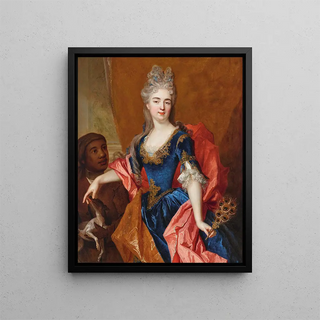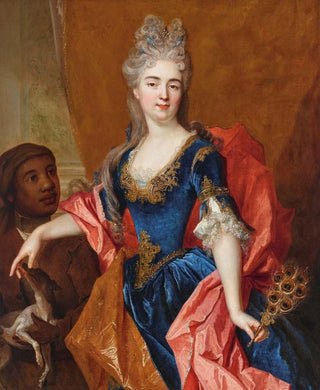Art print | Portrait of a lady holding a peacock feather fan with her servant holding a dog - Nicolas de Largillière


View from behind

Frame (optional)
The "Portrait of a lady holding a peacock feather fan with her servant holding a dog" by Nicolas de Largillière is a work that transcends the simple frame of a portrait to offer a true immersion into the aristocratic world of the 18th century. This painting, through its refinement and delicacy, invites the viewer to explore not only the identity of the depicted lady but also the social and cultural context of her time. The scene depicts a subtle intimacy between the characters, where each element, from the dog to the fan, seems loaded with meaning. The soft light bathing the entire composition enhances the charm and sophistication of this representation, making it a true jewel of French art history.
Style and uniqueness of the work
The uniqueness of this piece lies in Largillière's technical mastery, who manages to capture the ephemeral beauty of his subjects while imparting emotional depth. The choice of colors, both vivid and nuanced, as well as the meticulous details of the lady's clothing, demonstrate a particular attention to texture and light. The peacock feather fan, a symbol of status and refinement, becomes a central element of the composition, drawing the eye and revealing the elegance of the female figure. The servant, although secondary in action, adds a narrative dimension to the work, highlighting the power and service relations that characterize the aristocracy of the period. Thus, Largillière succeeds in creating an atmosphere that is both intimate and representative of a society in full transformation.
The artist and his influence
Nicolas de Largillière, an emblematic figure of 18th-century French painting, knew how to mark his era with his exceptional talent and unique style. Trained in the flourishing artistic context of his time, he skillfully combined Flemish influences and French traditions to develop an aesthetic that is his own. His portraits, often imbued with great dignity, testify to his ability to represent the personality of his models while incorporating symbolic elements.

Matte finish

View from behind

Frame (optional)
The "Portrait of a lady holding a peacock feather fan with her servant holding a dog" by Nicolas de Largillière is a work that transcends the simple frame of a portrait to offer a true immersion into the aristocratic world of the 18th century. This painting, through its refinement and delicacy, invites the viewer to explore not only the identity of the depicted lady but also the social and cultural context of her time. The scene depicts a subtle intimacy between the characters, where each element, from the dog to the fan, seems loaded with meaning. The soft light bathing the entire composition enhances the charm and sophistication of this representation, making it a true jewel of French art history.
Style and uniqueness of the work
The uniqueness of this piece lies in Largillière's technical mastery, who manages to capture the ephemeral beauty of his subjects while imparting emotional depth. The choice of colors, both vivid and nuanced, as well as the meticulous details of the lady's clothing, demonstrate a particular attention to texture and light. The peacock feather fan, a symbol of status and refinement, becomes a central element of the composition, drawing the eye and revealing the elegance of the female figure. The servant, although secondary in action, adds a narrative dimension to the work, highlighting the power and service relations that characterize the aristocracy of the period. Thus, Largillière succeeds in creating an atmosphere that is both intimate and representative of a society in full transformation.
The artist and his influence
Nicolas de Largillière, an emblematic figure of 18th-century French painting, knew how to mark his era with his exceptional talent and unique style. Trained in the flourishing artistic context of his time, he skillfully combined Flemish influences and French traditions to develop an aesthetic that is his own. His portraits, often imbued with great dignity, testify to his ability to represent the personality of his models while incorporating symbolic elements.






